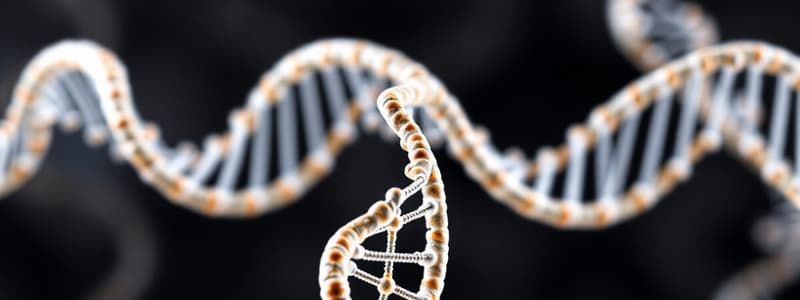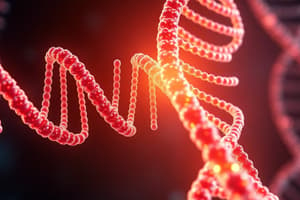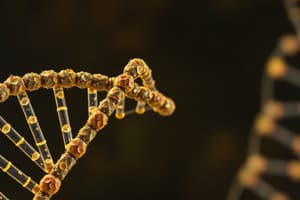Podcast
Questions and Answers
What does the primary structure of DNA primarily consist of?
What does the primary structure of DNA primarily consist of?
- A series of amino acids connected by peptide bonds
- Three-dimensional arrangements within chromosomes
- A sequence of nucleotide units linked by phosphodiester bonds (correct)
- A helical shape formed by hydrogen bonds
Which level of DNA structure describes its stable three-dimensional configuration?
Which level of DNA structure describes its stable three-dimensional configuration?
- Quaternary structure
- Primary structure
- Secondary structure (correct)
- Tertiary structure
What differentiates the sugar in RNA from the sugar in DNA?
What differentiates the sugar in RNA from the sugar in DNA?
- DNA has no sugar component
- RNA has an additional oxygen atom on the 2'-carbon (correct)
- RNA contains a hydroxyl group on the 3'-carbon
- The sugar in RNA is linear, while in DNA it is circular
What term is used to describe the arrangement of double-stranded DNA in chromosomes?
What term is used to describe the arrangement of double-stranded DNA in chromosomes?
What is considered a macromolecule in the context of DNA?
What is considered a macromolecule in the context of DNA?
What is the first component of a nucleotide?
What is the first component of a nucleotide?
Which of the following statements about purines and pyrimidines is true?
Which of the following statements about purines and pyrimidines is true?
What are the bonds connecting nucleotides in DNA called?
What are the bonds connecting nucleotides in DNA called?
What charge do phosphate groups carry in DNA?
What charge do phosphate groups carry in DNA?
Which nitrogenous base is found exclusively in RNA?
Which nitrogenous base is found exclusively in RNA?
What composes the backbone of a polynucleotide strand?
What composes the backbone of a polynucleotide strand?
Which term describes the directionality of a polynucleotide strand?
Which term describes the directionality of a polynucleotide strand?
Which of the following describes the secondary structure of DNA?
Which of the following describes the secondary structure of DNA?
What type of bonds hold the bases together on opposite strands of DNA?
What type of bonds hold the bases together on opposite strands of DNA?
What structure is described as the most stable configuration of DNA?
What structure is described as the most stable configuration of DNA?
Which base pairs with adenine (A) in DNA?
Which base pairs with adenine (A) in DNA?
Which statement accurately describes cytosine (C) pairing?
Which statement accurately describes cytosine (C) pairing?
What best describes the nature of the two polynucleotide strands in a DNA molecule?
What best describes the nature of the two polynucleotide strands in a DNA molecule?
What kind of spiral does B-DNA form?
What kind of spiral does B-DNA form?
What type of bond connects the sugar and phosphate groups within the same strand of DNA?
What type of bond connects the sugar and phosphate groups within the same strand of DNA?
The two polynucleotide strands of DNA run in the same direction.
The two polynucleotide strands of DNA run in the same direction.
The secondary structure of DNA is characterized by its nucleotide sequence and the way nucleotides are joined together.
The secondary structure of DNA is characterized by its nucleotide sequence and the way nucleotides are joined together.
Cytosine (C) pairs with adenine (A) through three hydrogen bonds.
Cytosine (C) pairs with adenine (A) through three hydrogen bonds.
The primary structure of DNA is considered to be a macromolecule because it consists of nucleotides linked together in a long chain.
The primary structure of DNA is considered to be a macromolecule because it consists of nucleotides linked together in a long chain.
The B-DNA structure is characterized by a left-handed spiral.
The B-DNA structure is characterized by a left-handed spiral.
The tertiary structure of DNA describes how the double-stranded DNA is packaged within chromosomes.
The tertiary structure of DNA describes how the double-stranded DNA is packaged within chromosomes.
Adenine (A) pairs exclusively with thymine (T) through two hydrogen bonds.
Adenine (A) pairs exclusively with thymine (T) through two hydrogen bonds.
The pentose sugar in DNA contains a hydroxyl group at the 2′-carbon position.
The pentose sugar in DNA contains a hydroxyl group at the 2′-carbon position.
Phosphodiester bonds are responsible for the linkages between the bases on opposite strands of DNA.
Phosphodiester bonds are responsible for the linkages between the bases on opposite strands of DNA.
The primary structure of DNA refers to its helical structure as determined by Watson and Crick.
The primary structure of DNA refers to its helical structure as determined by Watson and Crick.
Flashcards are hidden until you start studying
Study Notes
DNA Structure
- The primary structure of DNA consists of a chain of nucleotides linked together by phosphodiester bonds.
- Each nucleotide is composed of a sugar, a phosphate group, and a nitrogenous base.
- The deoxyribose sugar in DNA has a hydrogen atom attached to the 2’ carbon atom.
DNA Secondary Structure
- The secondary structure refers to the helical arrangement of the DNA molecule, which is referred to as a double helix due to the two DNA strands joining and winding around each other.
- The bases are stacked on the inside of the helix, while the sugar-phosphate backbones are on the outside.
- The two strands run in opposite directions (antiparallel) with the 5’ end of one strand opposite the 3’ end of the other strand.
- Hydrogen bonds link the bases on opposite strands, forming A-T and C-G base pairs.
DNA Tertiary Structure
- The tertiary structure of DNA refers to the packing and arrangement of the double-stranded DNA within chromosomes.
- B-DNA is the most stable configuration of DNA, with the double helix forming a right-handed (clockwise) coil known as an alpha helix.
Nucleosomes
- Nucleosomes are fundamental units of chromatin, composed of a core particle of eight histone proteins (two each of H2A, H2B, H3, and H4).
- DNA is wrapped around the histone octamer, forming a nucleosome core particle.
- The histone H1 protein is associated with the linker DNA, forming a chromatosome.
Chromatin Structure
- Nucleosomes are linked together by linker DNA to form a helical structure termed the 30 nm fiber.
- The 30 nm fiber further folds into loops of 20,000 - 100,000 bp, about 300 nm long.
- These loops condense and fold to from a 250 nm fiber through further coiling.
- The 250 nm fiber forms the chromatid, about 700nm in width.
Centromeres
- Centromeres are constricted regions of chromosomes where spindle fibers attach during cell division.
- Centromeres are essential for proper chromosome movement during mitosis and meiosis.
- Centromeric DNA sequences are the binding sites for the kinetochore, to which spindle fibers attach.
Telomeres
- Telomeres are the natural ends of the chromosomes, consisting of repetitive nucleotide sequences (TTAGGG in humans).
- They provide a cap that stabilizes the chromosome, preventing it from unraveling or being degraded.
- They also play a role in the replication of the ends of the chromosome.
Chromatin vs. Chromatid
- Chromatin refers to the complex of DNA and protein that makes up chromosomes and is found throughout the cell cycle.
- Chromatid refers to one of two identical copies of a chromosome that are formed during DNA replication.
- Chromosomes are condensed chromatin fibers that are visible during cell division.
DNA Structure
- DNA is a macromolecule consisting of a polymer chain made up of repeating nucleotides.
- Nucleotides consist of a sugar (deoxyribose in DNA), a phosphate group, and a nitrogenous base.
- The phosphate groups link the sugars of adjacent nucleotides to create the backbone of the DNA molecule.
- The 5' end of a DNA strand has a free phosphate group at the 5' carbon of the sugar, while the 3' end has a free hydroxyl group at the 3' carbon.
Secondary Structure of DNA
- DNA exists as a double helix comprised of two polynucleotide strands running in opposite directions (antiparallel).
- The strands are held together by hydrogen bonds between complementary bases.
- Adenine (A) pairs with thymine (T) via two hydrogen bonds.
- Cytosine (C) pairs with guanine (G) via three hydrogen bonds.
Tertiary Structure of DNA in Prokaryotes
- Most bacterial genomes consist of a single circular DNA molecule.
- Bacterial DNA is not associated with histone proteins but is complexed to other proteins.
- This complex forms a distinct region within the bacterial cell called the nucleoid.
Tertiary Structure of DNA in Eukaryotes
- Eukaryotic DNA is tightly packaged with the help of proteins, forming chromatin.
- Chromatin exists in two forms: euchromatin (less condensed, actively transcribed) and heterochromatin (more condensed, inactive).
- The basic unit of chromatin is the nucleosome, consisting of a core particle of eight histone proteins (two each of H2A, H2B, H3, and H4) wrapped by 147 bp of DNA.
- The nucleosome core particle is bound by an H1 histone, forming the chromatosome, which encompasses about 167 bp of DNA.
Chromosome Structure
- Eukaryotic chromosomes are linear and are composed of a single, extremely long DNA molecule.
- The centromere is a constricted region where spindle fibers attach, essential for proper chromosome movement during cell division.
- Telomeres are protective caps at the ends of chromosomes, preventing degradation and aiding in replication.
DNA Packaging Summary
- Nucleosomes fold to form a 30 nm fiber, which further folds into loops.
- These loops are further condensed and folded to produce a fiber with a diameter of 250 nm.
- Finally, tight helical coiling of the 250 nm fiber gives rise to a chromosome.
Key Terminology
- Chromatid: One half of a duplicated chromosome.
- Chromatin: Complex of DNA and protein found in eukaryotic cells.
- Chromatosome: Nucleosome bound to an H1 histone.
- Nucleosome: Core particle of eight histone proteins wrapped with DNA.
- Nucleoid: Region in bacterial cells containing DNA.
- Telomere shortening: Gradual reduction in telomere length associated with aging.
Studying That Suits You
Use AI to generate personalized quizzes and flashcards to suit your learning preferences.




